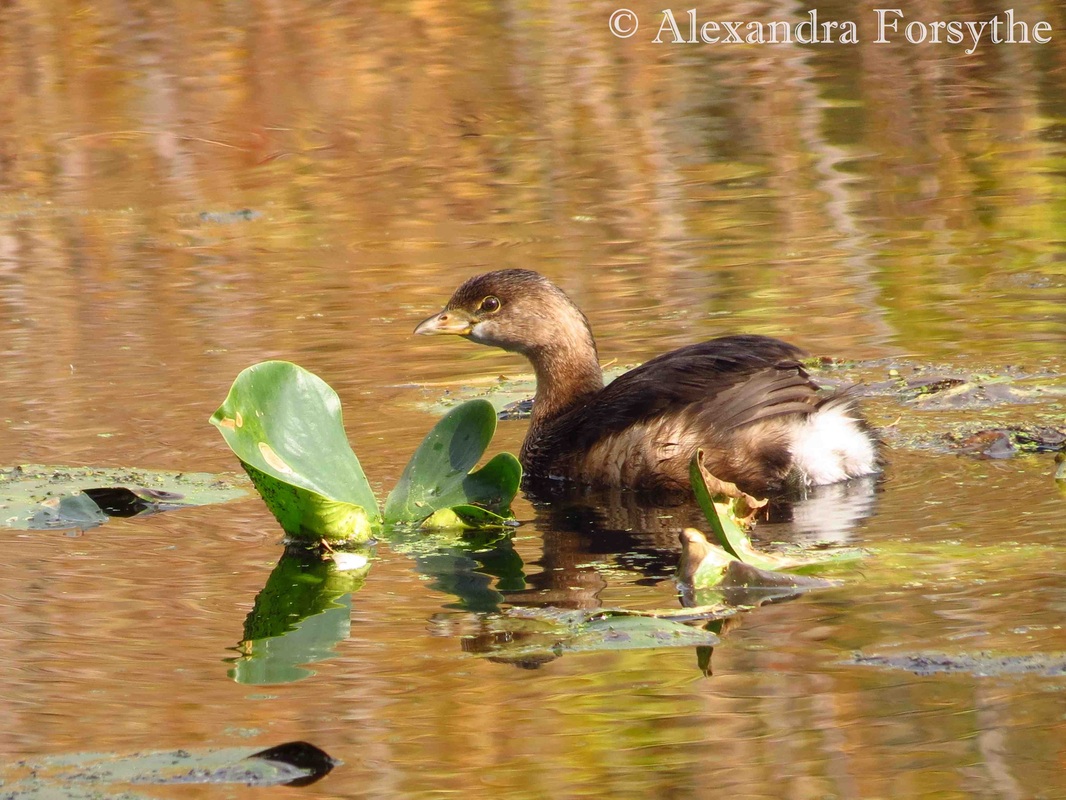The Pied-billed Grebe: a small, chunky waterfowl that behaves like an alligator and has almost as many feathers inside its body as outside! Behaving like an alligator and dining on its own feathers are both means of protection.
When startled, the Grebe often submerges, leaving only its eyes and nostrils above the surface of the water, watching the threat like a feathery, terrified alligator. Grebes can compress their feathers and squeeze out air, allowing them to submerge and remain at very specific depths for longer lengths of time.
In addition to helping with submersion, the feathers also allow the grebes to devour prey that would otherwise be harmful. To protect its stomach and intestines from the bones of its prey, the Grebe will swallow its own feathers. The feathers mix with the indigestible portions of the prey and form a pellet that the grebe regurgitates, much like raptors do. It’s not unusual for over half of the Grebe’s stomach to be filled with feathers!
The grebe possesses other interesting adaptations, such as the placement of the legs and shape of the toes. Their legs are positioned further back than most birds, acting as ideal propellers. The shape of the toes adds to the effect; the toes are lobed, not webbed, strongly resembling the blades of a propeller.
The Pied-billed is one of over twenty species of grebes. Three of the species (Columbian, Atitlan and Alaotra) have gone extinct since the 1970’s, and five more are endangered (Junin, Hooded, New Zealand, Titicaca and Madagascar). The Pied-billed populations declined somewhat from 1966 to 2010, but they are still widespread.
These small waterfowl are easy to spot once you know what to look for. During breeding season, they’ll be easy to identify with their “pied” (black banded) bill. You can find them in large, quiet ponds or small, undisturbed lakes that have a lot of cattails, water lilies and other vegetation.
The vegetation is also where you might spot a nest. If you see a circular mass of dead or dying vegetation, look closer. The Pied-billed prefers to build nests on floating plants that are rooted to the bottom of the pond or lake. Mud and additional vegetation are added to the nest throughout the season and keep the nest about 12 degrees Celsius warmer than the water. They are reclusive nesters, easily disturbed by humans. The wake from a canoe or kayak can create enough disturbance to destroy a nest or cause the eggs to fall into the water, so tread carefully! The chicks are colorful with rusty red, white and black stripes. When young, the chicks often ride on a parent’s back and may even accompany them on a dive!
I spotted this Pied-billed Grebe at Coffee Creek Park in Chesterton, Indiana. It was swimming quietly near the bank of a pond next to the road. It allowed me just enough time to take a photo before transforming into a submarine, diving into the depths and emerging on the far side of the pond some time later, almost disappearing in the vegetation.
When startled, the Grebe often submerges, leaving only its eyes and nostrils above the surface of the water, watching the threat like a feathery, terrified alligator. Grebes can compress their feathers and squeeze out air, allowing them to submerge and remain at very specific depths for longer lengths of time.
In addition to helping with submersion, the feathers also allow the grebes to devour prey that would otherwise be harmful. To protect its stomach and intestines from the bones of its prey, the Grebe will swallow its own feathers. The feathers mix with the indigestible portions of the prey and form a pellet that the grebe regurgitates, much like raptors do. It’s not unusual for over half of the Grebe’s stomach to be filled with feathers!
The grebe possesses other interesting adaptations, such as the placement of the legs and shape of the toes. Their legs are positioned further back than most birds, acting as ideal propellers. The shape of the toes adds to the effect; the toes are lobed, not webbed, strongly resembling the blades of a propeller.
The Pied-billed is one of over twenty species of grebes. Three of the species (Columbian, Atitlan and Alaotra) have gone extinct since the 1970’s, and five more are endangered (Junin, Hooded, New Zealand, Titicaca and Madagascar). The Pied-billed populations declined somewhat from 1966 to 2010, but they are still widespread.
These small waterfowl are easy to spot once you know what to look for. During breeding season, they’ll be easy to identify with their “pied” (black banded) bill. You can find them in large, quiet ponds or small, undisturbed lakes that have a lot of cattails, water lilies and other vegetation.
The vegetation is also where you might spot a nest. If you see a circular mass of dead or dying vegetation, look closer. The Pied-billed prefers to build nests on floating plants that are rooted to the bottom of the pond or lake. Mud and additional vegetation are added to the nest throughout the season and keep the nest about 12 degrees Celsius warmer than the water. They are reclusive nesters, easily disturbed by humans. The wake from a canoe or kayak can create enough disturbance to destroy a nest or cause the eggs to fall into the water, so tread carefully! The chicks are colorful with rusty red, white and black stripes. When young, the chicks often ride on a parent’s back and may even accompany them on a dive!
I spotted this Pied-billed Grebe at Coffee Creek Park in Chesterton, Indiana. It was swimming quietly near the bank of a pond next to the road. It allowed me just enough time to take a photo before transforming into a submarine, diving into the depths and emerging on the far side of the pond some time later, almost disappearing in the vegetation.

 RSS Feed
RSS Feed
